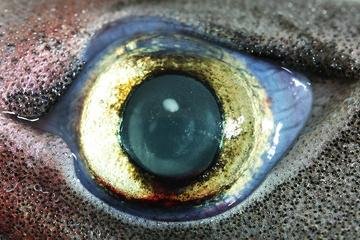The eye of a lantern shark, one of 50 bioluminescent sharks. (FNRS/UCL)
WASHINGTON, Aug. 7 (UPI) -- Deep in the sea, where the light from above begins to fade out -- a vast expanse known as the twilight zone -- there are strange glow-in-the-dark sharks. New research shows these sharks possess highly evolved eyes, enabling them to see in the dark and pick up light signals from their bioluminescent friends and enemies.
"There are about 50 different shark species that are able to produce light -- about 10 percent of all currently known sharks," Dr. Julien Claes, a marine biologist at the at The Catholic University of Louvain in Belgium, recently told Live Science.
Claes and a team of researchers discovered these bioluminescent sharks have a higher density of light-sensitive cells in their retinas, allowing them to pick out light and shadow when the differences between the two are minute.
In addition to looking at their eyes, researchers studied the ways these twilight zone sharks give off their own light -- an attempt to camouflage their bodies in the dim, but not pitch black, surroundings. Scientists also found many of these sharks have a transparent gap atop their eyelids, suggesting they interpret the levels of sunlight filtering down from above and then adjust their bioluminescence to blend in.
"That's always intriguing [to me] how an animal monitors both the down-welling light and its own bioluminescence to match the two," Julian Partridge, researcher at the University of Western Australia, told Australia's ABC.
Partridge is co-author of a new paper on the ways these sharks see and emit light in these lonely depths. The study was recently published in PLOS ONE.
Because these sharks use their light giving properties to communicate and locate prey, their eyes must constantly adjust depending on what the shark is looking for. Researchers suggest that this complexity is evidence that their eyes and bioluminescence evolved in conjunction -- a tandem system.
"This teaches us new things about the deep sea which is the biggest living space on the planet, and yet it's also the environment we know least about," Partridge added.















